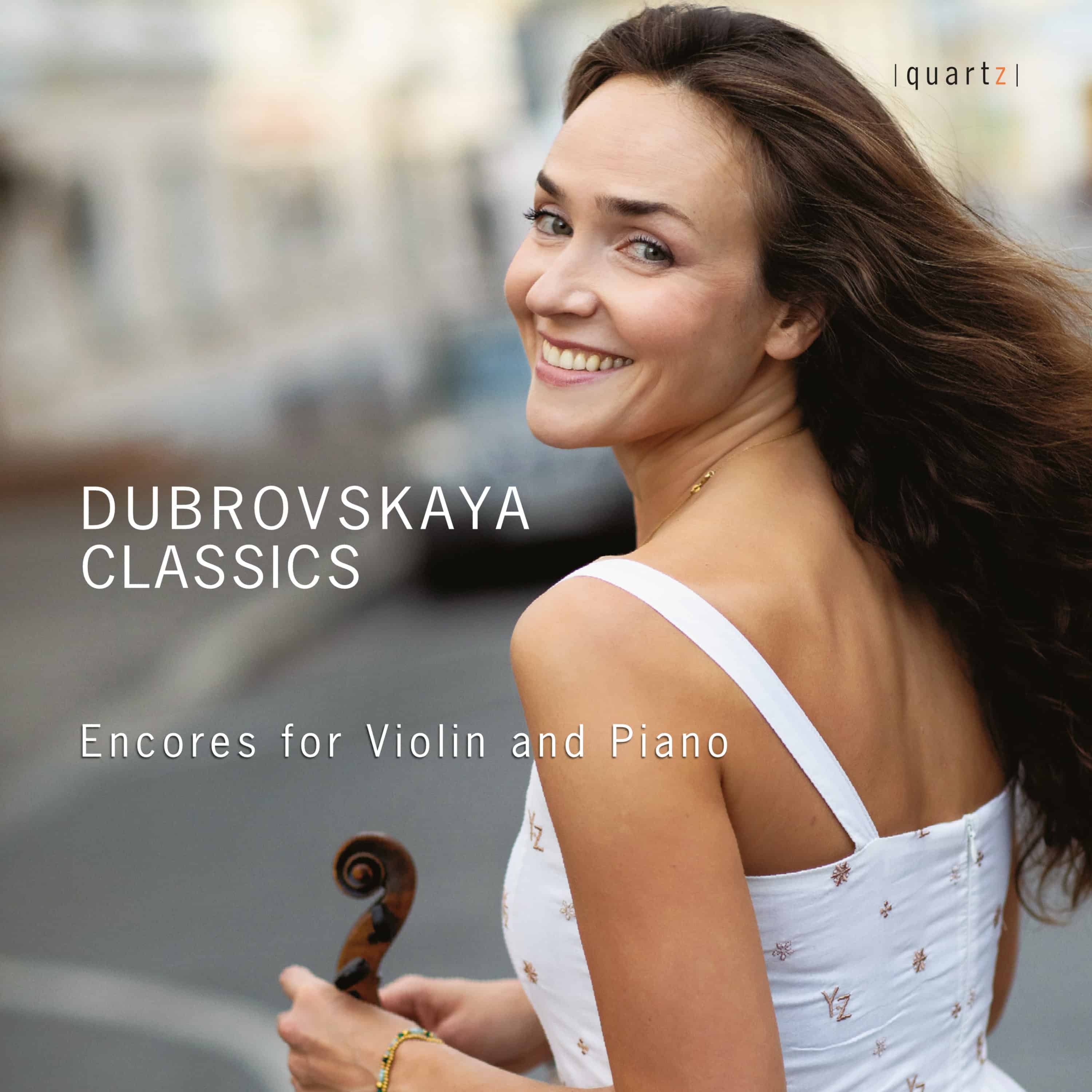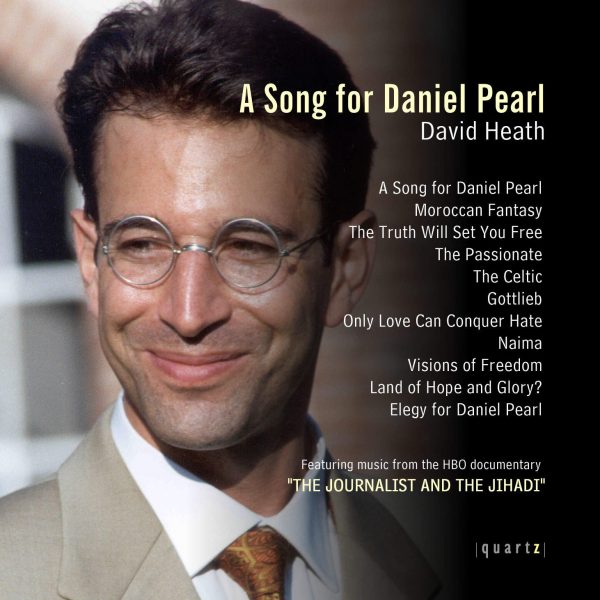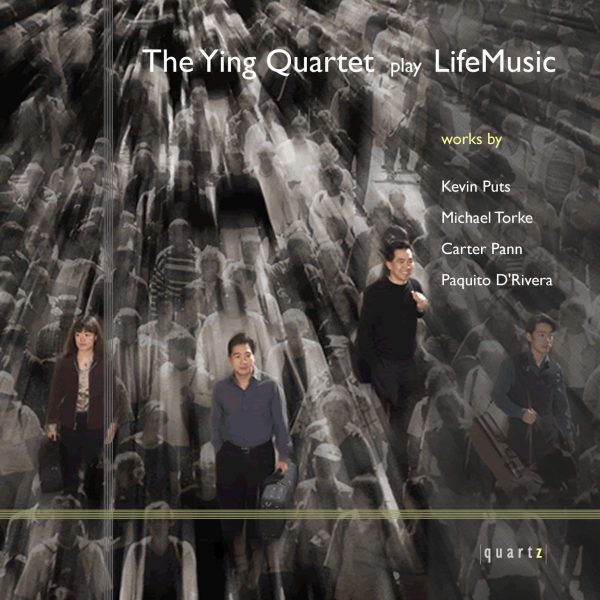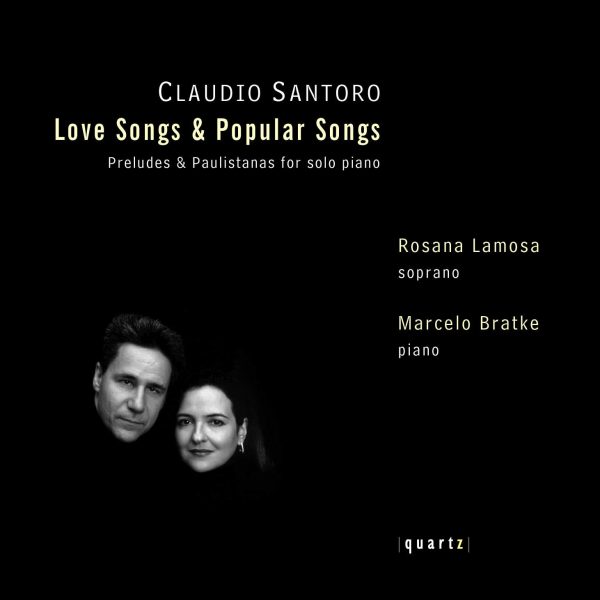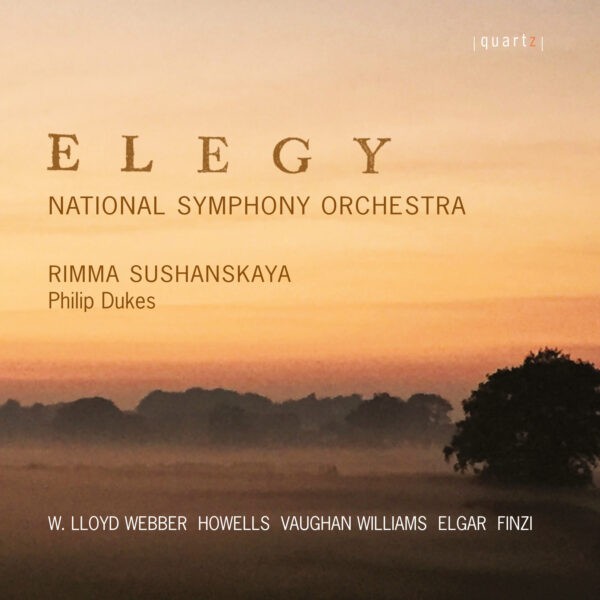Dubrovskaya Classics: Encores for Violin and Piano
Price range: £7.99 through £16.99
Ksenia Dubrovskaya is an exceptionally talented and charismatic violinist of the new generation. Ksenia’s passion for chamber music takes her across many continents, gracing renowned stages alongside many luminaries such as, Dmitry Sitkovetsky, Liana Isakadze, Bruno Canino, Konstantin Lifschitz, Alexander Knyzev, Philippe Graffin, Dariusz Mikulski and Derek Han. This album is a collection of the many encores that Ksenia has performed. In this album, esteemed pianist, Sona Barseghyan, accompanies Ksenia. Their performances showcase enchanting artistry and profound musicality, captivating audiences across continents. Ksenia performs on a violin crafted in Florence by Giovanni Battista Gabrielli in 1770 – the instrument leased by Reinhold Würth Musical Fund (Germany).
About This Recording
FOREWORD
The idea of recording a disc of popular and well-loved pieces of violin literature was born quite spontaneously.
I was offered the opportunity to record an album and was given complete freedom with the choice of repertoire.
At that moment, I was on tour in Armenia, with my partner, pianist Sona Barseghyan, where we performed the entire cycle of 10 Beethoven sonatas. I must say, at that time I was so in love with these sonatas, and especially through the performance of all 10 sonatas for three evenings, that I dreamed of converting more and more people to a religion called Beethoven. That’s why we performed them anywhere and everywhere and couldn’t get enough of them,
and as it should be, several encores followed each concert. Since the main programme remained unchanged, we allowed our imagination complete freedom during the encores. Throughout the concert, we and our audience were immersed in the world of deep and sizeable serious music, and as a result, at the end of the concert, the soul dictated something light and contrasting. The audience was very grateful to us for that. Since we always wanted to play different pieces, we accumulated a lot of miniatures, which we decided to record as soon as we had the opportunity. So, this album is a collection of my favourite encores that I give to my audience at the end of each concert and now I want to give it to you, dear listeners, with this recording.
Each piece in the album has its own story, whether it be funny or sad, they are my personal memories.
For example, I was invited to perform a piece by the Estonian composer, Arvo Pärt, Spiegel im Spiegel (Mirror in the Mirror) in the Vatican on the terrace of the residence of Pope Paul VI, which is located just between the sculptures on the enfilade above the square in front of St. Peter’s Cathedral.
Many of you will know the beauty and grandeur of this square, but few of you will have ever admired the view of the cathedral and this square from above. Frankly, unforgettable memories! They also became unforgettable because of a near incident at the concert. The entire violin part in this piece is a structure consisting of the sounds of the scale in a mirrored sequence of long notes, performed at a very slow bow rate. In the evening, during the concert, a breeze suddenly blew, occasionally intensifying, then subsiding, but for my light (almost motionless) moving bow it had an effect comparable to a hurricane. The breeze would slightly lift a light hair above the string, then shift it to the side. Whilst it may have been imperceptible to the audience, this little hair’s movement nevertheless had the power to distort the notes emanating from my violin.
So, in general, for me this concert turned out to be a struggle for life, in a natural disaster! After the concert, when I shared my feelings with the guests of the evening, everyone was extremely surprised by the story of my battle; as it seemed to them that they had been to ‘Paradise’, listening to magical music under the starry sky of the Vatican, whilst wafted by the lightest of breezes. That’s how different people’s perceptions of the same moment of reality can be!
Another very funny story is connected with playing Fratres by Pärt. When performing it at concerts, I always prefaced it with a story that I told audiences in order to get them immersed in the atmosphere of this wonderful piece. I told them roughly the following: ‘this piece is a theme with variations, where the theme itself – a phrase in a monorhythmic texture – is a procession of monks, brethren, in a medieval monastery, in the dark for morning prayer; and these cries of pizzicato chords at the end of each sequence are a bell calling monks to prayer’. That’s the story. I can’t tell you how I know it now, but it seemed to me that I wasn’t making it up. So there came the time when I performed Fratres in Berlin and introduced it with my story. However, after the concert, a Latvian cellist, who had been in the audience, came up to me and told me the real explanation of the name of the piece! It turns out that this piece was composed back in 1977 by Arvo Pärt, who was inspired by the Estonian ensemble of ancient music Hortus Musicus, whose musicians at that time performed in long robes, hence the brethren, ‘Fratres’! The colleague who came to the concert was well acquainted with Estonian musicians, and the composer himself back in the days, when the entire Baltic States were part of the Soviet Union. So, I’m telling both these stories at concerts now!
On the other hand, the three Old Viennese Waltzes by Fritz Kreisler, Liebesleid, Liebesfreud and Schön Rosmarin are associated with memories of their spontaneous performance on the Spanish island of Gran Canaria. A couple of years ago, a very famous Austrian conductor visited us at Finca.
One evening, I suddenly heard the first chords of Schön Rosmarin from the salon where the piano stands. I was surprised, but I didn’t take long to wait, I took out my violin and supported my partner! We did not notice how we played all three waltzes in a row, without scores or rehearsals, it came from the soul, which pleased all the household, who had gradually gathered around us!
I dedicate this CD to the memory of my dear parents. Without my mother, a pianist and teacher who passed away 27 years ago and without her patience and tremendous support, I would never have become a musician. My father, a golden man and a doctor from God, took part in the recording of this album – he turned the pages for Sona. Sadly, he passed away before this album was released. At his farewell ceremony, I played Gluck’s Mélodie, another piece extremely special to me and on this CD.
As you can see, this is a very personal album for me and therefore it is quite a touching moment for me to share it with you! I want to believe that it will give you a diverse range of emotions, from the extensive variety of wonderful pieces contained in it.
Dedicated to the memory of my parents, Elena and Oleg Dubrovsky
With love, yours, Ksenia
ENCORES FOR VIOLIN AND PIANO
La Campanella Ksenia Dubrovskaya’s selection of encores begins with Paganini, a figure synonymous with showmanship – to the extent that some thought he had made a pact with the devil, so fiendishly skilful was his violin playing. Liszt said of Paganini: ‘What a man, what a violin, what an artist! Heavens! What sufferings, what misery, what tortures in those four strings!’ Liszt had heard Paganini performing in Paris in April 1832, and he promptly set about writing a fantasy on Paganini’s ‘La clochette’, the theme of which Paganini in turn developed in the final movement of his Violin Concerto No.2. Liszt then based La Campanella, one of his six Études d’exécution transcendante d’après Paganini, on the same movement.
Air on the G String It seems likely that J.S. Bach’s four orchestral suites (BWV 1066-1069) date from his time in Leipzig, where he arrived in 1723; he may have been writing with Leipzig’s Collegium Musicum ensemble in mind. The Suite No.3 in D, BWV 1068, survives in orchestral parts dating from about 1731, and its light, hearty style may have been written to win over the council and people of Leipzig, with whom Bach had a prickly relationship. An advertisement for a concert that included this Suite states that it took place ‘at the Zimmermann Coffee House in the Cather Strasse’. It is pleasing to imagine hearing the Air (which follows the Ouverture) in that context. The movement was made famous as the Air on the G String after the German violinist August Wilhelmj arranged the work for violin and piano, transposing it into C and in the process allowing the entire violin part to fit comfortably on the lowest string, G.
Mélodie In 1878, Tchaikovsky busied himself writing his Violin Concerto while staying at the Swiss resort of Clarens on the shores of Lake Geneva. For the slow movement he wrote a ‘Méditation’ but set this aside when he realised that it would not work in this context. Reworked for violin and piano, the ‘Méditation’ became the
first movement of the Souvenir d’un lieu cher (Memory of a dear place) – but it was not Clarens to which Tchaikovsky was paying tribute. He made a start on the work when back in Russia, in May 1878, before travelling to his patroness Nadezhda von Meck’s Ukrainian estate in Brailivo (known today as Brailiv), finishing the work by the end of May and dedicating it to ‘B*******’ (almost certainly the place itself), making von Meck a present of the original manuscript. As with his famous Souvenir de Florence, Tchaikovsky created a musical postcard as a means of commemorating a special holiday, and the third piece, Mélodie, is characterised by its sweet melody and nostalgic harmonies.
Prelude from Partita No.3 We also hear the Prelude from Bach’s Partita No.3 BWV 1006, a piece he liked so much he transcribed it twice. The sunniest and most immediate of Bach’s three violin partitas, the Partita No.3 begins with this brilliant Prelude of almost continuous semiquavers, with passages of ‘bariolage’ – when the melody moves around one static, repeated note.
Romance Reinhold Glière was born in Kyiv, of German-Polish heritage; he changed his surname from Glier to Glière in 1900. His Romance for Violin and Piano in D major, Op.3 dates from 1902 and is a stand-alone piece in which the violin unfolds a nostalgic melody over delicate piano chords, building in passion and intensity before arriving at a gentle conclusion.
Fratres Arvo Pärt’s Fratres (meaning ‘Brothers’ in Latin) was composed in 1977 and was premiered by an Estonian early music group. Pärt has since arranged it for different combinations, with the violin and piano incarnation comprising a set of variations on the work’s original theme. This hypnotic version was composed for Gidon and Elena Kremer, who premiered it at the Salzburg Festival in 1980, and opens with an animated prelude for the violin alone, unfolding a long-breathed
crescendo. The chant-like theme is articulated by the piano eight times, over which the violin adds elegant decoration to form a set of variations.
Mélodie Another famously beautiful melody is the haunting Dance of the Blessed Spirits from Gluck’s opera Orfeo ed Euridice. The theme comes from the Act Two ballet, set in Elysium. Mélodie was premiered in Vienna in 1862 and epitomised Gluck’s aesthetic of noble simplicity, becoming his most popular work.
Zirani Zar Komitas was an Ottoman-Armenian priest and musician who was a pioneer of ethnomusicology, meticulously transcribing Armenian folk songs during the first decade of the 20th century. Among his most famous works is the Three Pieces for violin and piano, the first of which is the hauntingly beautiful Zirani Zar (‘Apricot Tree’), with its distinctive folk rhythms and soaring lines.
Beau soir Beau soir is a song composed by Debussy when he was about 15 or 16, in 1877 or 1878. It was originally to a poem by Paul Bourget, one of the composer’s favourite writers, as his fellow composition students at the Paris Conservatoire noted. Raymond Bonheur described Debussy arriving for classes ‘at the last minute, coming across the courtyard of the old Conservatoire with the short, hurried steps that always characterised him… Most of his settings of Bourget date from those long distant days’. The song was published in 1891
and features Debussy’s already characteristically hazy piano harmonies supporting a creamy melody, heard here in an arrangement by the celebrated violinist
Jascha Heifetz.
Spiegel im Spiegel We also hear Avro Pärt’s Spiegel im Spiegel (1978), which can mean ‘Mirror in the mirror’ or ‘Mirrors in the mirror’, referring to an infinity mirror; Pärt’s ‘tintinnabuli’ style, based on bell-like sonorities, creates a mesmerising effect as the repeated triads are ‘mirrored’ with small variations.
Russian Dance from Swan Lake The first production of Tchaikovsky’s ballet Swan Lake took place on 4 March 1877 at the Bolshoi Theatre in Moscow. The Russian ballerina Anna Sobeshchanskaya was cast in the principal role of Odette, and at her request Tchaikovsky added some specially composed music for a ‘pas des deux’, producing a number of national dances including the Danse Russe, with its almost improvisatory violin line.
Cantabile Paganini’s Cantabile evokes the bel canto tradition, with a song-like violin melody of great expressivity and intimacy. Cantabile is a lyrical gem characterized by its singing melodies and showcases Paganini’s ability to evoke deep emotion through the violin, enchanting audiences with its sublime beauty and heartfelt lyricism.
Krunk Krunk meaning ‘Crane’, is based on a medieval Armenian song faithfully preserved by Komitas. Krunk captures the essence of Armenian nature and folklore, evoking longing. For many Armenian pilgrims on their travels, the crane was a symbol of sorrow and nostalgia.
Dance Espagnole, Liebesfreud, Liebesleid and Schön Rosmarin The great Austrian-American violinist-composer Fritz Kreisler specialised in creating music for his own instrument that was at once virtuosic and charming, often inspired by other composers; the Danse Espagnole is based on music from Manuel de Falla’s opera La Vida Breve (‘Life is Short’). Kreisler’s Alt-Wiener Tanzweisen (‘Old Viennese Melodies’) consist of three gems: the carefree ‘Liebesfreud’, heartfelt ‘Liebesleid’ and enchanting Schön Rosmarin. Kreisler often performed these pieces as encores, and the first two of the set were transcribed by his friend Rachmaninov. Kreisler’s teachers included Bruckner, Delibes and Massenet.
Méditation from Thaïs Our recital ends with Massenet’s serene ‘Méditation’ from his opera, Thaïs. Played between scenes in Act Two, this entr’acte has become a celebrated concert work in its own right, ending with the violin line ascending into the ether.
© Joanna Wyld, 2024
KSENIA DUBROVSKAYA
Ksenia Dubrovskaya is an exceptionally talented and charismatic violinist of the new generation. She was keen to make a personal statement with this album.
Ksenia is proud of both her femininity and feminism. She recognises the struggles that women, and female artists in particular, have endured in order for women such as herself to be able to express their art. With Massenet’s exquisite Meditations and Kreisler’s Schön Rosmarin in this album, she pays passionate tribute to them but also to those who continue to press forward for women’s complete emancipation in the arts and society as a whole.
Born in Kolomna near Moscow into a family of musicians, Ksenia’s journey began with regional victories, culminating in triumph at the prestigious Tchaikovsky Competition for Young Musicians.
Her dedication led her to excel at the Moscow State Conservatory under the tutelage of Professor Irina Bochkova, followed by a Master of Music in Performing Arts degree from the Zurich High School of Music, studying with esteemed tutors, Professors Zakhar Bron and Marc Kissoszy.
Ksenia’s passion for chamber music has taken her across continents, gracing renowned stages alongside luminaries such as Yuri Bashmet, Dmitry Sitkovetsky, Liana Isakadze, Bruno Canino, Konstantin Lifschitz, Alexander Knyazev, Philippe Graffin, and Derek Han.
As a soloist, she’s commanded the attention of world-class orchestras, conducted by maestros like Saulius Sondeckis, Justus Frantz, Shinik Hahm, Jacek Kaspszyk and Helmut Müller-Brüll.
The Würth family presenting to Ksenia their violin crafted in Florence by Giovanni Battista Gabrielli in 1770
She is the artistic director of the Finca Festival in Gran Canaria, Spain. Ksenia has headed up the concert series Ksenia Dubrovskaya and Friends in Künzelsau, Germany since 2019.
Ksenia performs on a violin crafted in Florence by Giovanni Battista Gabrielli in 1770 – the instrument loaned out by Reinhold Würth Musical Fund (Germany) to outstanding musicians.
Ksenia is not only renown for the power, elegance, precision and passion in her performances. She is also masterful in her portrayals of the delicate awe and precious fragility of humanity stood before the primordial forces of the universe; and yet that joy of being alive and able to experience its wonders.
Her performances resonate with a profound connection to the human experience, transcending the notes to capture the delicate balance of existence.
With meticulous attention to detail Ksenia is able to evoke the composers’ subtlest feelings and yet to bring out her own reflections on the comedy of life.
On stage, her violin is not a third party, for she has that capacity to fuse so totally with her instrument that, as they rock and sway together, one is left unsure who is directing whom, creating a Holy Trinity of performer, violin and composer, woven together to enthral our senses.
Through her interpretation, she invites listeners to rediscover the profound beauty and enduring relevance of classical music. For lovers of classical music, Ksenia’s album promises an unforgettable experience, blending virtuosity with emotional depth to create a transcendent musical odyssey.
www.ksenia-dubrovskaya.com
SONA BARSEGHYAN
Sona’s musical journey began in 1989 in Yerevan, Armenia. At the age of seven, she discovered her passion for the piano at the Tchaikovsky Music School, setting the stage for a remarkable career. Her dedication led her to the Yerevan State Conservatory, where she studied under Professor Sergey Sarajyan and earned both her B.A. and M.A. degrees with distinction from 2006 to 2012.
Continuing her pursuit of excellence, Sona ventured to Cologne, Germany, where she studied at the Cologne Conservatory under Prof Nina Tichman. In 2014, she obtained her second M.A. degree, followed by a Ph.D. in 2016.
Sona’s musical prowess extends beyond academia. She participated in masterclasses with renowned pianists such as Norma Fisher, Evgeny Kissin, and others, refining her skills and expanding her repertoire. Her debut solo recital at age eight marked the beginning of a flourishing career, earning accolades from international competitions in Armenia, Georgia, Italy and Germany.
Notably, she achieved second prize at the Khachaturian International Competition in 2007, gaining recognition on the global stage. Her talent was further acknowledged with the ‘Youth Prize for Achievements in Performing Classical Music’ by the President of Armenia in 2009. As a chamber musician, Sona has collaborated with esteemed artists, gracing festivals worldwide. Her performances, from the Moscow Conservatory to Carnegie Hall, showcase her enchanting artistry and profound musicality, captivating audiences across continents. Sona’s journey embodies a harmonious blend of technical brilliance, emotional depth, and unwavering dedication to the craft of classical music.
www.sona-barseghyan.com
Track Listing
- Niccolò Paganini: La Campanella Op.7, MS.48 (arr. Fritz Kreisler)
- JS Bach: Air on the G String
- Pyotr Ilyich Tchaikovsky: Mélodie Op.42, No.3
- JS Bach: Preludio from Partita No.3 in E major
- Reinhold Glière: Romance Op.3
- Arvo Pärt: Fratres
- Christoph Willibald Gluck: Mélodie (arr. Fritz Kreisler)
- Komitas: Zirani Zar (arr. A. Gabrielyan)
- Claude Debussy: Beau soir (arr. Jascha Heifetz)
- Arvo Pärt: Spiegel im Spiegel
- Pyotr Ilyich Tchaikovsky: Russian Dance from Swan Lake
- Niccolò Paganini: Cantabile
- Komitas: Krunk (arr. S. Aslamazyan)
- Enrique Granados: Danse Espagnole (arr. Fritz Kreisler)
- Fritz Kreisler: Liebesfreud
- Fritz Kreisler: Liebesleid
- Fritz Kreisler: Schön Rosmarin
- Jules Massenet: Meditation from Thaïs
